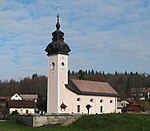world.wikisort.org - Slovenia
Pri Cerkvi–Struge (pronounced [pɾi ˈtseːɾkʋi ˈstɾuːɡɛ]; Slovene: Pri Cerkvi - Struge, in older sources also Pricerkev and Pri cerkvi[2][3]) is a village in the Municipality of Dobrepolje in Slovenia. The area is part of the historical region of Lower Carniola. The municipality is now included in the Central Slovenia Statistical Region.[4]
Pri Cerkvi–Struge | |
|---|---|
 | |
 Pri Cerkvi–Struge Location in Slovenia | |
| Coordinates: 45°46′58.55″N 14°46′35.29″E | |
| Country | |
| Traditional region | Lower Carniola |
| Statistical region | Central Slovenia |
| Municipality | Dobrepolje |
| Area | |
| • Total | 3.2 km2 (1.2 sq mi) |
| Elevation | 421.2 m (1,381.9 ft) |
| Population (2020) | |
| • Total | 66 |
| • Density | 21/km2 (53/sq mi) |
| [1] | |
Name
Pri Cerkvi–Struge is a compound name; pri cerkvi means 'at the church' and refers to the parish church. Struge (German: Strug[2]) is a regional designation referring to the entire southern part of the Dobrepolje karst polje, also including the villages of Četež pri Strugah, Kolenča Vas, Lipa, Podtabor, Potiskavec, Rapljevo, Tisovec, and Tržič.[3] The name Struge literally means 'river channels' (from the Slovene common noun struga) and is a relatively frequent element in place names.[5]
Church

The local parish church is dedicated to Saint Augustine and belongs to the Roman Catholic Archdiocese of Ljubljana. It is a medieval church that was extensively rebuilt in the mid-19th century.[6]
History
During the Second World War, a number of civilians from Pri Cerkvi–Struge were murdered on 28 July 1942 and buried in the Žiglovica Cave Mass Grave (Slovene: Grobišče Jama Žiglovica) in Ribnica.[7]
Gallery
- 2010 high-water mark
- Chapel-shrine
References
- Statistical Office of the Republic of Slovenia
- Leksikon občin kraljestev in dežel zastopanih v državnem zboru, vol. 6: Kranjsko. 1906. Vienna: C. Kr. Dvorna in Državna Tiskarna, p. 50.
- Krajevni leksikon Dravske Banovine. 1937. Ljubljana: Zveza za tujski promet za Slovenijo, p. 231.
- Dobrepolje municipal site
- Snoj, Marko. 2009. Etimološki slovar slovenskih zemljepisnih imen. Ljubljana: Modrijan and Založba ZRC, pp. 399–400.
- "EŠD 2359". Registry of Immovable Cultural Heritage (in Slovenian). Ministry of Culture of the Republic of Slovenia. Retrieved 2 March 2011.
- Žiglovica Cave Mass Grave on Geopedia (in Slovene)
External links
Другой контент может иметь иную лицензию. Перед использованием материалов сайта WikiSort.org внимательно изучите правила лицензирования конкретных элементов наполнения сайта.
WikiSort.org - проект по пересортировке и дополнению контента Википедии


